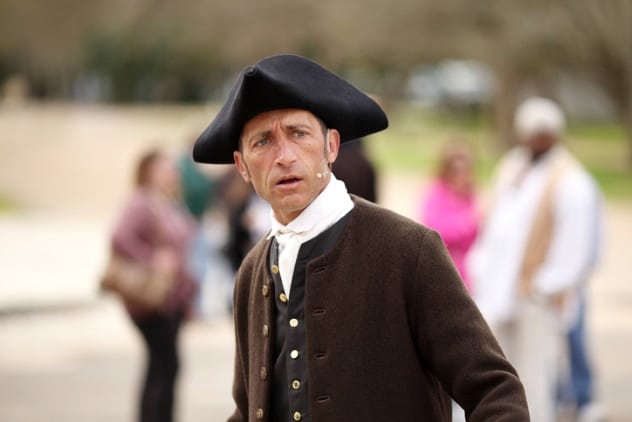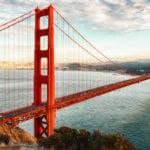 Mysteries
Mysteries  Mysteries
Mysteries  History
History 10 Surprising Stories About the Texas Rangers
 Humans
Humans 10 Philosophers Who Were Driven Mad by Their Own Theories
 Miscellaneous
Miscellaneous 10 Video-Game-Worthy Weapons and Armors from History
 Weird Stuff
Weird Stuff 10 Psychics Who Accurately Predicted Wartime Events
 The Arts
The Arts 10 Pieces of Art Inspired by a Broken Heart
 Health
Health 10 Science Fiction-Sounding New Medical Treatments
 History
History 10 Surprising Facts About the Father of Submarine Warfare
 Space
Space Ten Astonishing New Insights into Alien Worlds
 Weird Stuff
Weird Stuff 10 Bizarre Summer Solstice Rituals Still Practiced Today
 Mysteries
Mysteries Top 10 Haunting Facts About the Ghost Ship MV Alta
 History
History 10 Surprising Stories About the Texas Rangers
 Humans
Humans 10 Philosophers Who Were Driven Mad by Their Own Theories
Who's Behind Listverse?

Jamie Frater
Head Editor
Jamie founded Listverse due to an insatiable desire to share fascinating, obscure, and bizarre facts. He has been a guest speaker on numerous national radio and television stations and is a five time published author.
More About Us Miscellaneous
Miscellaneous 10 Video-Game-Worthy Weapons and Armors from History
 Weird Stuff
Weird Stuff 10 Psychics Who Accurately Predicted Wartime Events
 The Arts
The Arts 10 Pieces of Art Inspired by a Broken Heart
 Health
Health 10 Science Fiction-Sounding New Medical Treatments
 History
History 10 Surprising Facts About the Father of Submarine Warfare
 Space
Space Ten Astonishing New Insights into Alien Worlds
 Weird Stuff
Weird Stuff 10 Bizarre Summer Solstice Rituals Still Practiced Today
10 Lesser-Known Facts About Revolutionary-Era America
The earliest period of US history has been so mythologized that it is sometimes hard to get a grip on what life was actually like during this time. As longtime Listverse readers know, whatever you learned in school about it probably won’t be much help. So, just in time for Independence Day, let’s take a look at the American Revolution.
You probably thought of this period as a time in which a bunch of scrappy underdogs with ideals and practices of political and social decorum rose up to defeat their oppressors. As with most aspects of history, this conception is both true and untrue in ways that are surprising, fascinating, fascinatingly surprising, and surprisingly fascinating. (Comment below if we’re missing any adjectives.)
10 Americans Were Taller Than The British

The American colonists are often portrayed as the scrappy underdogs, fighting for independence against their English rulers. Being a cobbled-together group of militias fighting against the most formidable military power of the time, this was true, for the most part. The colonists, however, did boast one advantage over the English: height. While the average Englishman of the time stood around 165 centimeters (5’5″), the average American man would tower over them by a staggering 8 centimeters (3 in). Scholars have hypothesized that this is because of better nutrition in 18th-century America. There may simply have been more food available for colonists and thus more opportunity to get the nutrition they needed.
While it would be difficult to characterize the exact effect of this height advantage on the outcome of the Revolutionary War, we would be hard-pressed to say there was none. I mean, imagine leaving your home to fight a bunch of people you perceived to be a bunch of backwoods outdoorsmen, half-expecting them to look like Bigfoot, only to find that they all have three inches on you, at least somewhat confirming your Bigfoot notions. I, for one, would be on the first boat back to London (assuming I didn’t get shot for desertion, that is).
9 Americans Had A Higher Literacy Rate Than The British

One might think that because the British were the largest empire of the time that their mainland would be one seeping with widespread intelligence and culture, but this wasn’t necessarily the case, at least in relation to the American colonies. While 18th-century Great Britain maintained a 40-percent literacy rate among males (France was even worse with 29 percent), New England boasted a 70-percent literacy rate.[1] This high literacy rate could have been a second advantage the colonies had over the British. Much of the support for the revolution came from the spreading of pro-revolution propaganda such as Thomas Paine’s Common Sense. As we all know, literary propaganda really only works on those who can read; it’s common sense.
The high literacy rate was perhaps due to two factors. The first was that the very populous New England colonies were largely dominated by Puritans, who valued education for religious purposes. Puritans demanded a lot of Bible-reading. The second was that, due to the flourishing colonial economy of the time, which mainly consisted of farming activities, there was an extreme abundance of food. This meant that kids could spend less time working for their parents and more time working on their education.
8 One In Three Women Who Walked Down The Aisle Were Pregnant

Colonial Americans are normally thought of as a bunch of stiffs who only worked and read the Bible, while eschewing sex, alcohol, and art, and in many cases, this portrayal was accurate. Historically, Puritans, for example, banned gambling, closely regulated drinking, and banned mixed dancing between men and women because they thought it might lead to fornication.
So one might be surprised to learn that more than one in three women in the late 1700s was pregnant while walking down the aisle.[2] A possible reason for this was the traditional act of bundling, in which a man and a woman, during the process of courtship, would be encouraged to share a bed for a night in order to test their compatibility. A bundling board would be placed between them (or a sack around one of them) in order to discourage any sexual activity. If anything was learned from this practice, it’s that if you put two people in a bed and tell them not to have sex, they start thinking of sex, and then they want to have sex, and then they have sex.
7 Americans Drank . . . A Lot

Much has been made in recent years of the rising problem with binge drinking in the United States, but in the context of history, the drinking habits of Americans today don’t even hold a candle to those of colonial Americans. While Americans today drink a modest 8.7 liters (2.3 gal) of alcohol per capita annually, the average American in 1790 drank 129 liters (34 gal) of beer and cider, 19 liters (5 gal) of distilled spirits, and 3.8 liters (1 gal) of wine.[3]
Alcohol, however, was simply a practical choice. Before water purification and the understanding of bacteria, Americans believed that water was unhealthy because it often made them sick, whereas alcohol did not, leading to the belief that it was healthy. Alcohol was a normal part of daily life, being consumed even at breakfast and work. Craftsmen and hired hands would often drink at work, and John Adams famously began every day with a draft of hard cider and ended the day with three glasses of Madeira.
How did Paul Revere so effectively warn everyone that the British were coming? It wasn’t by knocking on each and every person’s door like a magazine salesman. He stopped at many crowded taverns on his way from Boston. Without alcohol, who knows? The United States might not exist.
6 South Carolina: One Of The Most Tolerant And Cultured Of The Colonies

With all of the art that we know the United States has produced today and the aforementioned high literacy rate of colonial Americans during the 18th century, one might be surprised to learn that the arts were not so successful in America during that time. One reason for this is because the Puritan-dominated New England colonies and Quaker-dominated Pennsylvania historically banned art that did not focus on God. The Puritans, for example, banned theater for what they perceived as its sexual nature.
South Carolina, however, was not dominated by any one religion.[4] It was a mix of Methodists, Baptists, Quakers, Jews, Anglicans, and Presbyterians, all of whom built churches that supported each other, leading to a relatively pluralistic and tolerant society where culture could flourish. (Methodists and Baptists had inclusive congregations and allowed black people to be recognized as preachers.)
5 The Peak Of Blood Sports

In 18th-century America, there was no football on television, no video games, and you weren’t allowed to gamble or go to the theater (depending on which colony you lived in), so what else was there to do but mess with animals?
Blood sports peaked in colonial America during the 18th century. Most people today are familiar with a favorite pastime of 18th-century Americans known as cockfighting, but not as many are familiar with bear-baiting, an activity which involved the worrying or tormenting of bears or pitting them against other animals. Many times, bears would be chained to a pole and forced to fight off hordes of dogs.
Another popular activity of the time was an import of Dutch culture known as goose pulling. In this, a live goose with a greased head would be fastened to a rope or pole, and a man riding a horse at full speed would try to grab its head in an attempt to rip it off.[5]
4 Newspaper Editors Had To Carry Guns

Most people are familiar with the practice of dueling, which was prevalent in 18th-century colonial America and perhaps made famous by the later duel between political rivals Aaron Burr and Alexander Hamilton. During a time in which the free press was just starting to flourish, people were not so used to having their character or political viewpoints attacked as viciously and publicly as the wide distribution of the printing press allowed.
This often put newspaper editors quite literally in the line of fire. Newspapers during the time were very biased in their political viewpoints, and as a result, editors were challenged to duels so often that they had to keep a firearm with them at all times, even at the office, just in case an irate reader charged in and demanded a duel.[6]
3 Nova Scotia Could Have Been Considered The 14th Colony

Before the Revolutionary War, there really was no conception of the 13 colonies as Americans know them today. There was simply British North America, of which Nova Scotia was a part. Three quarters of Nova Scotia’s population were New Englanders, and on a few occasions, various Nova Scotian groups attempted to join the American Revolution through acts of insurrection and correspondence with patriot leaders. For example, a shipment of hay to be used in Boston as forage against American rebels was burned in Halifax before it could be loaded on to the ship.[7]
A group of Nova Scotian emissaries also traveled to Boston in order to meet with the Continental Congress and convince George Washington to invade Nova Scotia. Washington denied their request, perhaps because his last offensive attempt in Quebec had gone so poorly. The Nova Scotian rebels did, however, go on to launch a few military actions back home but were ultimately unsuccessful. (The campaign is known in Canada as “Eddy’s Rebellion.”)
2 Thomas Jefferson Consumed Opium Habitually

Many see the opioid crisis of the United States today as a fairly new one, but the history of opium in the US stretches back much further. In fact, the Founding Fathers themselves had their own encounters with the drug. By now, because of recent pushes to legalize marijuana, we all know that Thomas Jefferson grew hemp on his plantation, but fewer people know he grew opium as well.
Because opium is an effective antidiarrheal, Jefferson turned to it later in life because of his, well, chronic diarrhea. He often used what was an early form of laudanum, an alcoholic solution containing opium. Jefferson felt so much better on the drug that he once wrote to a friend describing his use of laudanum as “habitual.”[8]
1 Politics Were Very, Very Uncivil

A lot is made of the incivility in American politics today, with people pining for a time in which political parties and politicians from opposite sides of the political spectrum treated each other with respect, but this is simply a misrepresentation of politics in the United States. You may not have had televised presidential debates in which candidates talked about the size of their genitalia, but this is only because there wasn’t television, and there weren’t yet public presidential debates. Otherwise, the most powerful politicians were most certainly discussing their genitalia in public forums. John Adams, for example, once wrote of Alexander Hamilton:
What a pity it is that our Congress had not known this discovery, and that Alexander Hamiltons project of raising an Army of fifty thousand Men, ten thousand of them to be Cavalry and his projects of Sedition Laws and Alien Laws and of new Taxes to Support his army, all arose from a superabundance of secretions which he could not find Whores enough to draw off? and that the Same Vapours produced his Lyes and Slanders by which he totally destroyed his party forever and finally lost his Life in the field of honor.[9]
All of this is to ignore the fact that people would actually shoot each other over political differences, such as that most famous instance in which Aaron Burr killed Alexander Hamilton in a duel. So pine not for the so-called civil days of American politics, unless you wish to see a duel between two candidates, which is a bad example because we would all definitely watch that on TV.
Kevin Klatman is a stand-up comedian, writer, and actor from Colorado. He has performed stand-up all over the United States and has acted in a bevy of commercials and will also appear in the upcoming movie The Wilderness Pilot. His writing has been featured in The Hard Times, Listverse, and Savage Henry Magazine.
Read more about Revolutionary-era America on 10 Astonishing Facts About America’s Founding Fathers and 10 Unsolved Mysteries From The American Revolution.






![11 Lesser-Known Facts About Mass Murderer Jim Jones [Disturbing Content] 11 Lesser-Known Facts About Mass Murderer Jim Jones [Disturbing Content]](https://listverse.com/wp-content/uploads/2020/09/jonestown2-copy-150x150.jpg)

